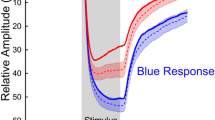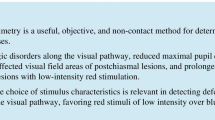Abstract
· Background: Differences between the pupillomotor sensitivity of nasal and temporal retinal hemifields may contribute to the relative afferent pupillary defect (RAPD) seen in optic tract or pretectal lesions. To understand the architecture of the pupillary pathway, it is necessary to know the size and the prevalence of such naso-temporal differences and also of contraction anisocoria (unequal direct and consensual pupillary responses) in normal individuals. The results of previous studies have been only partially consistent. · Methods: We registered the direct and consensual pupillary light reactions in both central retinal hemifields of 42 healthy subjects by means of IR video pupillography. Stimuli were generated under mesopic conditions on a computer screen as half-circles with 4.6 cd/m2 and 10 deg radius. Stimulus duration was 200 ms with a stimulation interval of 4 s. · Results: The nasal retina was significantly more sensitive than the temporal retina, and the direct pupillary reactions were significantly larger than the consensual reactions. For the nasal retina, direct pupillary reactions exceeded the consensual reactions, whereas there was nearly no difference between direct and consensual reactions for the temporal retina.· Conclusion: RAPD in optic tract damage or pretectal lesions cannot be explained by the only slightly more sensitive nasal retina. Considerably more input would be needed from the contralateral than from the ipsilateral retina into the optic tract. The nearly equal direct and consensual pupil reactions when stimulating the temporal retina suggest an input of temporal retina to both sides of the pretectum. Such a crossing of temporal fibres may take place in the chiasm.
Similar content being viewed by others
Author information
Authors and Affiliations
Additional information
Received: 9 February 1999 Revised: 22 April 1999 Accepted: 1 June 1999
Rights and permissions
About this article
Cite this article
Schmid, R., Wilhelm, B. & Wilhelm, H. Naso-temporal asymmetry and contraction anisocoria in the pupillomotor system. Graefe's Arch Clin Exp Ophthalmol 238, 123–128 (2000). https://doi.org/10.1007/PL00007879
Issue Date:
DOI: https://doi.org/10.1007/PL00007879




